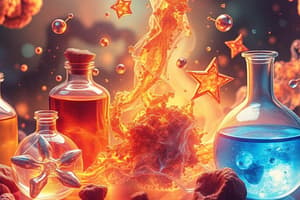Podcast
Questions and Answers
What type of mixture has a uniform composition throughout?
What type of mixture has a uniform composition throughout?
- Colloidal mixture
- Homogeneous mixture (correct)
- Heterogeneous mixture
- Suspension mixture
Which of the following correctly describes a compound?
Which of the following correctly describes a compound?
- Created by chemically bonding two or more types of atoms (correct)
- Made of multiple elements that are not chemically combined
- Composed of one type of atom
- A simplest form of matter that can exist independently
What phase change occurs when a liquid turns into a gas?
What phase change occurs when a liquid turns into a gas?
- Sublimation
- Evaporation (correct)
- Freezing
- Condensation
Which factor does NOT affect the rate of a chemical reaction?
Which factor does NOT affect the rate of a chemical reaction?
In which state of matter do particles have a definite shape and volume?
In which state of matter do particles have a definite shape and volume?
What is the atomic number of an atom?
What is the atomic number of an atom?
What does the formula H₂O represent?
What does the formula H₂O represent?
Which of the following is a correct representation of a molecule?
Which of the following is a correct representation of a molecule?
In a balanced chemical equation, what must be true?
In a balanced chemical equation, what must be true?
Which of these elements is correctly matched with its symbol?
Which of these elements is correctly matched with its symbol?
Flashcards are hidden until you start studying
Study Notes
Pure Substances vs. Mixtures
- Pure Substances: Composed of one type of particle, can be elements or compounds.
- Elements: Made up of only one type of atom (examples: gold, oxygen).
- Compounds: Formed from two or more types of atoms chemically bonded (example: water H₂O).
- Mixtures: Contains two or more substances physically combined, not chemically bonded.
- Homogeneous Mixtures: Uniform composition; components are evenly distributed (example: saltwater).
- Heterogeneous Mixtures: Non-uniform composition; components are distinct (example: salad).
Atoms, Molecules, Elements, and Compounds
- Atom: The fundamental unit of matter, retains chemical properties.
- Molecule: Two or more atoms bonded together (examples: O₂, H₂O).
- Element: Comprised solely of one type of atom (examples: helium, carbon).
- Compound: Two or more types of atoms chemically combined (examples: NaCl, CO₂).
Particle Theory
- Phase Changes: Matter transitions between solid, liquid, and gas due to energy changes (heat).
- Melting: Solid to liquid.
- Evaporation: Liquid to gas.
- Condensation: Gas to liquid.
- Freezing: Liquid to solid.
- Expansion: Increased temperature causes particles to move faster and spread apart.
- Diffusion: Movement of particles from high to low concentration.
Density
- Density Formula: Density = Mass / Volume
- Density Units:
- Liquids: g/mL
- Solids: g/cm³
- Example: A material with mass 10g and volume 5cm³ has a density of 2g/cm³.
Properties of Solid, Liquid, and Gas
- Solid: Particles are tightly packed with a definite shape and volume.
- Liquid: Particles are closely packed but can move; definite volume but no fixed shape.
- Gas: Particles are widely spaced, moving freely; neither definite shape nor volume.
Chemical vs. Physical Changes
- Physical Change: Alters state or appearance without changing the substance (examples: melting, freezing).
- Chemical Change: Forms new substances with different chemical properties (examples: burning, rusting).
Rates of Reaction
- Temperature: Higher temperatures boost particle energy, elevating reaction rates.
- Concentration: Increasing reactant concentration leads to more collisions.
- Surface Area: Smaller particles enhance surface area, boosting reaction speed.
- Catalysts: Speed up reactions without being consumed in the process.
- Pressure: For gases, increased pressure brings particles closer, resulting in more collisions.
Model of Atoms
- Protons: Positively charged particles found in the nucleus.
- Neutrons: Neutral particles also located in the nucleus.
- Electrons: Negatively charged particles orbiting the nucleus.
- Atomic Number: Total number of protons in an atom.
- Mass Number: Total count of protons and neutrons in an atom.
Formulas of Atoms and Molecules
- Atoms: Denoted by elemental symbols (example: C for Carbon).
- Molecules: Represented by atomic symbols with subscripts indicating number of atoms (example: H₂O for water).
Periodic Table Names and Symbols
- Elemental Symbols: Represent elements using one or two letters (examples:
- C for Carbon
- N for Nitrogen
- Na for Sodium
- O for Oxygen)
- Chemical Formulas:
- H₂O: Water (2 Hydrogen + 1 Oxygen)
- H₂: Hydrogen gas (2 Hydrogen atoms)
- CO₂: Carbon Dioxide (1 Carbon + 2 Oxygen atoms)
Chemical Equations
- Representation: Illustrate chemical reactions with reactants transitioning into products.
- Example Equation: 2H₂ + O₂ → 2H₂O
- Balancing: Ensures equal numbers of each atom on both sides of the equation for conservation of mass.
Studying That Suits You
Use AI to generate personalized quizzes and flashcards to suit your learning preferences.




